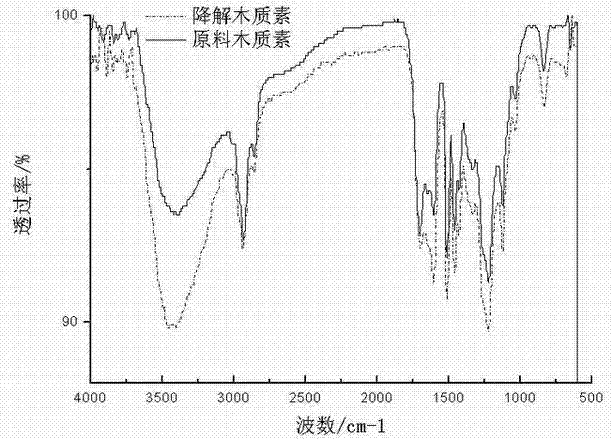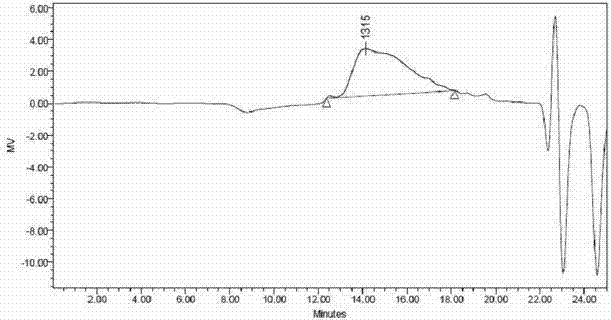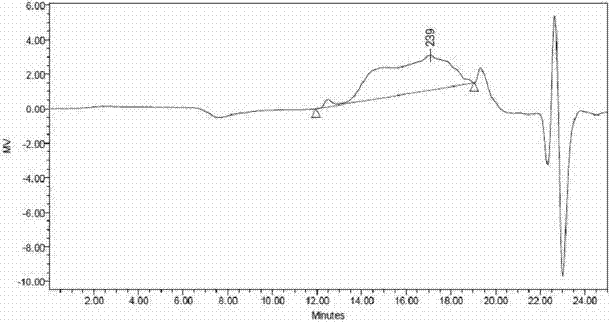Lignin-modified phenolic foam and preparation method thereof
A technology of phenolic foam and lignin, which is applied in the field of lignin-modified phenolic foamed plastics, can solve the problems of slag removal and poor phenolic foam toughness, and achieves the effects of cost reduction, foam toughness improvement and dependency reduction.
- Summary
- Abstract
- Description
- Claims
- Application Information
AI Technical Summary
Problems solved by technology
Method used
Image
Examples
Embodiment 1
[0036] Dissolve 25g of acid-hydrolyzed lignin (20% substitute for phenol) in 30g of water, add aqueous sodium hydroxide solution to adjust the pH to 8, connect the ozone generator, and react at 50°C for a period of time. Adjust the temperature to 80-85°C, add 60% phenol and 50% formaldehyde (phenol-formaldehyde molar ratio 1:1.7), pH to 8.5, after a certain period of reaction, add the remaining phenol and formaldehyde, pH to 8.5, and then react for a certain period of time and heat up to 90°C, continue to react until the viscosity is suitable, cool down to 80°C, neutralize with acetic acid to pH 6-7, dehydrate under reduced pressure to a solid content of 80%, and obtain lignin-modified resole phenolic resin. The resin is blended with n-pentane, hydrochloric acid and Tween-80 to foam and solidify to obtain lignin modified phenolic foamed plastics.
[0037] Lignin modified phenolic foam properties: density 80-30kg / cm 3 ; Closed cell rate ≥ 80%; its compressive strength (compre...
Embodiment 2
[0042] 42.9g of corn cob alkali lignin (30%wt instead of phenol) was dissolved in 40g of water, and the pH was adjusted to 8 by adding sodium hydroxide aqueous solution, connected to the ozone generator, and reacted at 50°C for a period of time. Adjust the temperature to 80-85°C, add 60% phenol and 50% formaldehyde (phenol-formaldehyde molar ratio 1:1.7), pH to 8.5, after a certain period of reaction, add the remaining phenol and formaldehyde, pH to 8.5, and then react for a certain period of time and heat up to 90°C, continue to react until the viscosity is suitable, cool down to 80°C, neutralize with hydrochloric acid to pH 6-7, and dehydrate under reduced pressure to a solid content of 80%, to obtain a lignin-modified resole phenolic resin. The resin is blended with n-pentane, hydrochloric acid and Tween-80 to foam and solidify to obtain lignin modified phenolic foamed plastics.
[0043]
Embodiment 3
[0045] Dissolve 42.9g of kraft lignin (30% substitute for phenol) in 40g of water, add potassium hydroxide aqueous solution to adjust the pH to 8, connect the ozone generator, and react at 50°C for a period of time. Adjust the temperature to 80-85°C, add 60% phenol and 50% formaldehyde (phenol-formaldehyde molar ratio 1:1.5), pH to 8.5, react for a certain period of time, add the remaining phenol and formaldehyde, pH to 8.5, then react for a certain period of time and heat up to 90°C, continue to react until the viscosity is suitable, cool down to 80°C, neutralize with acetic acid to pH 6-7, dehydrate under reduced pressure to a solid content of 80%, and obtain lignin-modified resole phenolic resin. The resin is blended with n-pentane, hydrochloric acid and Tween-80 to foam and solidify to obtain lignin modified phenolic foamed plastics.
[0046]
PUM
| Property | Measurement | Unit |
|---|---|---|
| compressive strength | aaaaa | aaaaa |
| dimensional stability | aaaaa | aaaaa |
| optical density | aaaaa | aaaaa |
Abstract
Description
Claims
Application Information
 Login to View More
Login to View More - R&D
- Intellectual Property
- Life Sciences
- Materials
- Tech Scout
- Unparalleled Data Quality
- Higher Quality Content
- 60% Fewer Hallucinations
Browse by: Latest US Patents, China's latest patents, Technical Efficacy Thesaurus, Application Domain, Technology Topic, Popular Technical Reports.
© 2025 PatSnap. All rights reserved.Legal|Privacy policy|Modern Slavery Act Transparency Statement|Sitemap|About US| Contact US: help@patsnap.com



